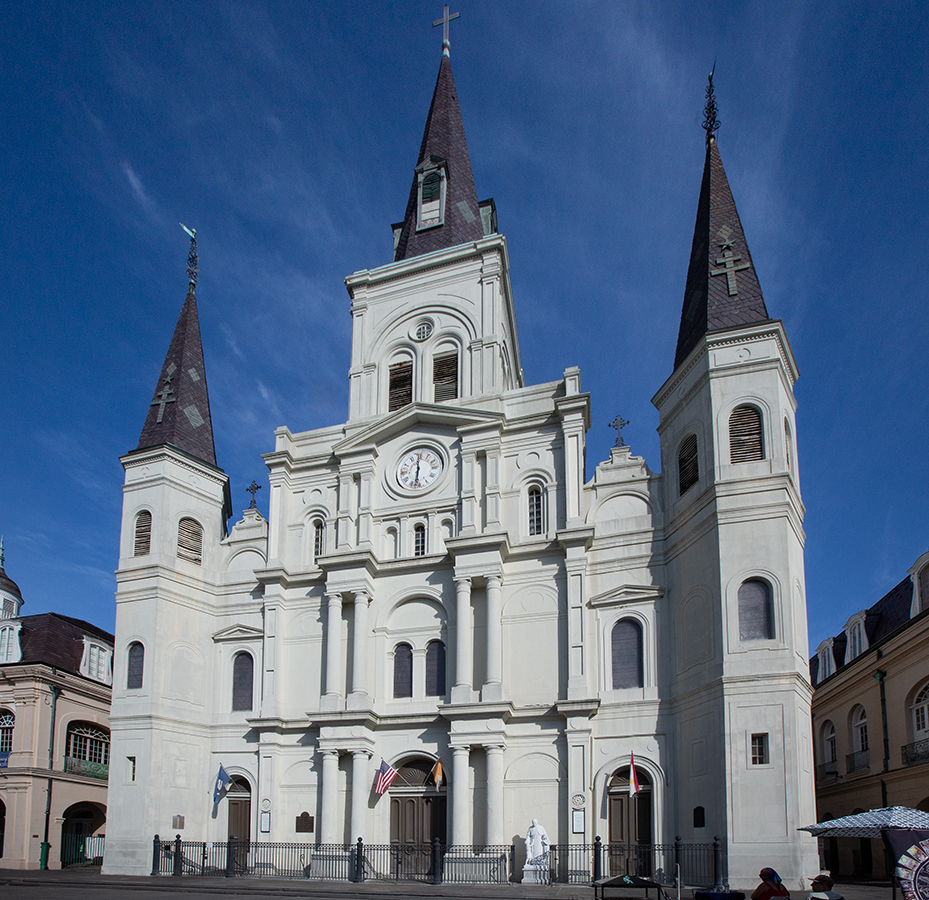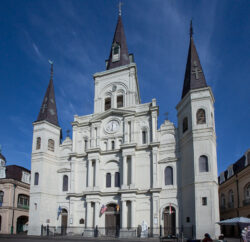St. Louis Cathedral
Since 1850, the St. Louis Cathedral’s impressive three-steeple facade has become the city’s most recognizable building.

The Louisiana Endowment for the Humanities
The façade of St. Louis Cathedral in New Orleans, 2023. Melissa Carrier, photographer.
St. Louis Cathedral, mother church of Louisiana’s extensive Catholic population, is the international symbol of New Orleans. Among the tallest buildings in the French Quarter, the cathedral is flanked by the Cabildo, where the Louisiana Purchase was signed, and the Presbytere, site of the former home of Capuchin monks; together, these buildings frame the rear of Jackson Square and face the Mississippi River. Since 1850, the cathedral’s impressive three-steeple facade has been the backdrop for presidential speeches, diplomatic visits, and countless tourist snapshots, gradually becoming not only New Orleans’s most recognizable building but also the iconic image of the city.
New Orleans was founded in 1718, and the Catholic parish of St. Louis was established in 1720. When French military engineer Adrien De Pauger arrived to lay out the colonial city in 1721, plans designated this location for a parish church dedicated to Saint Louis, but it was three years before construction began. De Pauger’s 1724 drawings show a cruciform church about 112 feet long and 32 feet wide. Below a hipped roof was a colombage structure braced on the sides by buttresses, which proved unnecessary when the newly established brickyard provided material to fill the spaces of the timber frame. The church was probably the town’s first briquette-entre-poteaux (brick-between-posts) building. The entire structure was sheathed with chamfered planks to protect the frame and soft brick, and the façade was elegantly worked to imitate a cut stone façade. Elements such as quoins, a circular window, and a pediment carved with Christian symbols emulate the Louis XIV style, then popular in France. Above the entrance was an octagonal, domed belfry; by 1731, two bells and a clock had been installed. The interior—very finished for the church’s era and location—featured plaster walls and ceiling, a carved altar, and wooden pews. The clergy ordered glass for the windows, pictures, a silver cross, and six candelabra from France. Dedicated in 1727, St. Louis Parish Church served residents for several decades, but deferred maintenance resulted in severe deterioration. In 1766, the building closed for repairs. Upon reopening, the church was again New Orleans’s religious center and remained so until a devastating fire leveled most of the city on March 21, 1788. Father Antonio de Sedella (Père Antoine) wrote that “in less than half an hour [the fire] engulfed the Parish Church and Presbytere without our being able to salvage the sacred vessels of the former and part of the archives…in the latter.”
Rebuilding did not begin immediately, but by 1789, church fathers had cleared the ruins and found a benefactor, Don Andres Almonester y Rojas, who agreed to build a new church at his expense. Work progressed slowly, but in the fall of 1794, the building was finished according to the designs of colonial engineer Gilberto Guillemard. Hailed as the finest building in the colony, the large plastered brick church was Spanish in concept, with twin hexagonal towers capped by bell-shaped roofs. A balustrade disguised a low-pitched terrace roof. In plan, the building consisted of a central space divided into three aisles by brick pillars. The building barely escaped a second fire in December 1794, and on Christmas Eve, worshippers attended service at the new church, now dedicated as a cathedral. An 1806 traveler described the building as “plastered and painted in the front to give the impression of marble.” Inside was a magnificent altar with paintings and sculpture.
In 1819, the city council and church trustees decided to share the expense of obtaining a clock and bell from France and erecting a tower to contain them. Plans were submitted by local engineer and architect Benjamin Buisson and by Benjamin Latrobe, designer of the first cathedral built in the United States, the neoclassical Basilica of the National Shrine of the Assumption of the Blessed Virgin Mary in Baltimore. Latrobe’s design was selected, as it was judged to complement the cathedral’s architecture perfectly. Over the next decades, St. Louis Cathedral was repaired and whitewashed, an imported organ was installed, and decorative painting was completed.
In the 1830s, church wardens began to discuss remodeling and enlarging the old church to create a building more modern in appearance and impressive enough to assert the continued importance of the “Old Quarter.” To this end, they hired the most noted of the French-born architects working in the city: J. N. B. de Pouilly. He submitted several designs, but it was not until March 1849 that a construction contract was signed with builder John Patrick Kirwan. Although the project was termed a “restoration,” eventually the old church was virtually demolished, leaving only the lower portions of the front wall. In 1850, a massive construction accident brought down the central tower and portions of the walls, but work continued, and on December 7, 1851, Archbishop Antoine Blanc blessed the new cathedral in a colorful public ceremony.
De Pouilly’s design in the manner of French Romanticism was distinctly modern. The combination of Roman motifs, underlying medieval-inspired shapes, and an unconventional openwork iron steeple created controversy in the city. Historian Charles Gayarré called the building an “upstart production of bad taste,” and architect Thomas K. Wharton observed, “The modernized exterior of the Church of St. Louis, and its skeleton spire of perforated iron work are but an indifferent substitute for the venerable, weather-stained picturesque turrets of the ‘olden time.’” The unusual spire leaked and was sheathed in slate in 1859.
Other writers published in contemporary newspapers were more admiring of the new design. One commented, “The most beautiful points in the architecture of different ages are brought into requisition in the sacred edifice, and when completed, both the internal and external appearance of the building will be magnificent.” The curate traveled to Ghent, Belgium, to purchase three “admirably carved” marble altars adorned with statues. Paintings, chandeliers, a mahogany cathedra, or throne, for the archbishop, and four fonts in colored marble were among the interior embellishments.
During succeeding decades, murals were repainted, and major structural and decorative renovations took place in 1918, in 1938, between 1956 and 1961, and following Hurricane Katrina in 2005. In 1964, Pope Paul VI designated the cathedral a minor basilica with the official title of Basilica of St. Louis King of France, but it continues to be popularly known as St. Louis Cathedral.
The cathedral has been associated with many of the city’s most historic events. General Andrew Jackson asked the Reverend Louis William Valentine DuBourg—soon to become the second bishop of the Diocese of Louisiana—to offer a mass of thanksgiving there following the Battle of New Orleans in January 1815; the future president and members of his victorious army attended. The largest of the cathedral’s bells, which is rung at the top of every hour, dates to 1819 and was named Victoire in honor of the American victory in the Battle of New Orleans. Another future president, General Zachary Taylor of Baton Rouge, visited the cathedral after the Battle of Buena Vista in the Mexican War. Religious services were held at the cathedral in December 1903 as part of the city’s celebration of the Louisiana Purchase centennial. The site has been a community gathering spot following severe hurricanes through the centuries; President George W. Bush used it to dramatic effect as the backdrop to his primetime speech from the city days after Hurricane Katrina, and a much-anticipated Mass at the cathedral about a month after the hurricane’s landfall was one of the first post-Katrina public events in New Orleans. St. Louis Cathedral has been visited by kings and emperors, princes and prime ministers, and, most notably, Pope John Paul II in 1987. The pedestrian plaza between the front of the cathedral and Jackson Square was renamed for the pope following his historic visit.
